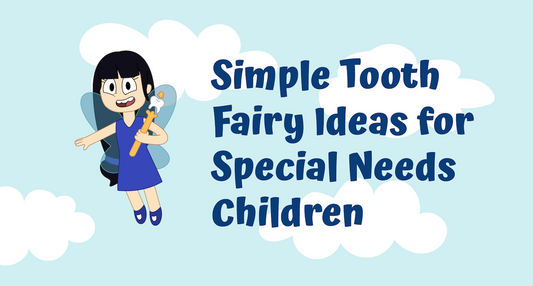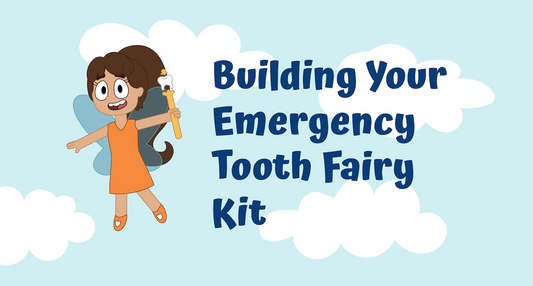Every parent faces that moment—when curious little minds start asking increasingly probing questions about the tooth fairy. Whether your child is hearing conflicting stories from friends at school or simply developing their critical thinking skills, navigating these conversations with thoughtfulness preserves the magic while respecting your child's growing understanding of the world.
Why Children Question the Tooth Fairy
Understanding why children begin questioning magical traditions helps you respond appropriately:
Developmental Milestones: Around ages 7-9, children naturally develop more logical thinking and begin distinguishing fantasy from reality—precisely during prime tooth-losing years.
Peer Influence: School-aged children compare notes with friends, often bringing home conflicting information or doubts about the tooth fairy's existence.
Inconsistencies: Perhaps the tooth fairy "forgot" one night, left different amounts than expected, or siblings received different gifts—these inconsistencies naturally prompt questions.
Growing Curiosity: As children mature, their natural curiosity leads them to seek more detailed explanations about how the tooth fairy operates.
Common Challenging Questions and Thoughtful Responses
"Is the tooth fairy real?"
Rather than answering directly, try: "What do you think about the tooth fairy? Why are you wondering about this now?"
This response respects their critical thinking while allowing you to gauge why they're asking and what they already believe.
If they persist, you might say: "The tooth fairy represents something very special—the way we celebrate growing up and taking care of our bodies. Some things feel more magical when we keep a sense of wonder about them."
"How does the tooth fairy get into our house?"
A magical answer might be: "Tooth fairies have special magic that allows them to sense when a tooth has fallen out. They can become very tiny—smaller than a mouse—and slip under doors or through tiny openings that only fairy magic can find."
For families who enjoy crafting, you might even create a special fairy door as the tooth fairy's personal entrance.
"Why didn't the tooth fairy come last night?"
If the tooth fairy "missed" a visit: "Tooth fairies collect teeth from children all over the world, and sometimes they have so many to collect that they get behind schedule. They always come eventually because every child's tooth is important to them."
This explanation acknowledges that sometimes parents forget while preserving the magical explanation.
"My friend got $20 for her tooth but I only got $2. Why?"
Address economic differences with: "Tooth fairies work differently for different families. They're careful to bring gifts that make sense for each child and home they visit. What matters most is celebrating your growing up, not what comes under the pillow."
For more information about typical tooth fairy gift amounts, see our guide to tooth fairy economics.
"Dad, I saw YOU putting money under my pillow!"
If caught in the act: "Sometimes parents help the tooth fairy when she's especially busy. She trusts certain grown-ups to assist on special nights when too many teeth come out at once."
When Children Are Ready for the Truth
Eventually, most children directly or indirectly signal they're ready for a more mature understanding. Signs might include:
- Directly stating they know the tooth fairy isn't real
- Asking questions that show they've figured it out but want confirmation
- Setting "traps" to test the tooth fairy's existence
- Mentioning friends who no longer believe
When these moments arrive, consider:
Honor Their Growth: "I'm really impressed with how you've been thinking about this. You're showing such mature understanding."
Preserve the Wonder: "Now you're old enough to understand the special secret of the tooth fairy—it's a wonderful tradition parents and children share to make growing up more magical."
Invite Them Into the Magic: "Now that you know the secret, you can help keep the magic alive for younger children and even help with your younger siblings someday."
Emphasize the Value: "Even though the tooth fairy visits differently than you imagined, the celebration of your growing up is very real and important to our family."
Keeping the Magic Alive for Younger Siblings
When older children discover the truth while younger siblings still believe, create a special "magic keeper" role:
Establish Confidence: "This is a grown-up secret I'm trusting you with because you've shown such maturity."
Create Partnership: "Would you like to help make the tooth fairy magic special for your little sister? You could help choose special gifts or write fairy notes."
Acknowledge Maturity: "Being a magic keeper is a special responsibility that shows how grown-up you're becoming."
Transitioning to New Traditions
As children outgrow the tooth fairy belief, you can create new ways to acknowledge this developmental milestone:
Tooth Fairy "Graduation" Certificate: Create a special document commemorating their years of tooth fairy visits and welcoming them to the "magic keepers" club.
Memory Box Completion: Finish their tooth loss journey with a complete memory collection including photos, notes, and mementos from their tooth fairy years.
New Milestone Markers: Introduce new ways to celebrate growing up that feel more mature but still special.
Balancing Magic and Honesty: A Delicate Dance
Throughout the tooth fairy years, balancing wonder with honesty requires thoughtfulness:
Avoid Direct Untruths: Instead of definitive statements that might later feel like deception, use open-ended language like "Many people believe..." or "The story goes..."
Follow Their Lead: Let children's questions guide how much information to share rather than volunteering explanations they haven't sought.
Honor Their Perspective: If they express skepticism, acknowledge their thinking with "That's thoughtful reasoning" rather than dismissing their doubts.
Emphasize the Meaning: Focus conversations on why we celebrate these milestones and the importance of marking growth, rather than on the literal existence of magical beings.
Conclusion: The Lasting Value of Childhood Magic
The tooth fairy tradition offers far more than just excitement about small gifts under pillows. It provides children with:
- Comfort during what might otherwise be a scary physical change
- Celebration of normal development and growth
- Family traditions that create lasting memories
- A gentle introduction to symbolic thinking
- The experience of wonder and magic in everyday life
However your family navigates the inevitable questions about the tooth fairy, approaching these conversations with respect for your child's development preserves the joy of this special tradition while supporting their growing understanding of the world.
Remember that the tooth fairy visits for just a brief window in childhood—typically six years at most. Creating magical experiences during this time, while respectfully addressing questions as they arise, gives your child both the gift of wonder and the gift of trusting their own developing reasoning.
Want to enhance your family's tooth fairy experience? The Hi Tooth Fairy app introduces children to Birdie, Frankie, Lulu, Piper, Tulip, and Winnie – the six tooth fairy friends from Flutterville who make losing teeth a magical adventure!




